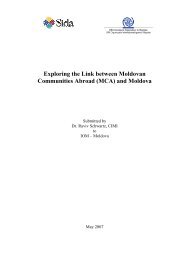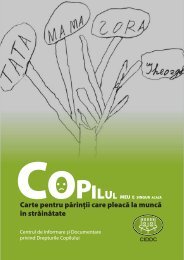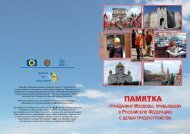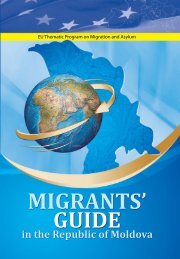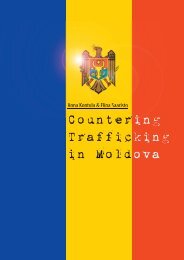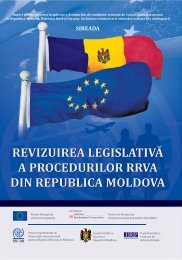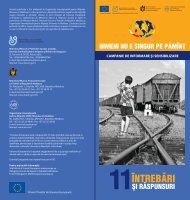Trafficking in Human Beings in Southeastern Europe - Iom
Trafficking in Human Beings in Southeastern Europe - Iom
Trafficking in Human Beings in Southeastern Europe - Iom
- No tags were found...
You also want an ePaper? Increase the reach of your titles
YUMPU automatically turns print PDFs into web optimized ePapers that Google loves.
<strong>Traffick<strong>in</strong>g</strong> <strong>in</strong> <strong>Human</strong> Be<strong>in</strong>gs<strong>in</strong> <strong>Southeastern</strong> <strong>Europe</strong>S<strong>in</strong>ce July 2001, as a result of <strong>in</strong>creased bar raids, a number of bars have beenclosed. Police bar raids have also proved not very effective <strong>in</strong> stopp<strong>in</strong>g traffick<strong>in</strong>g.Often bar owners are tipped off and prepared for the police visit. Closureof bars and nightclubs does not mean that the traffick<strong>in</strong>g is stopped, butrather that it is moved to private apartments, hotels and motels where thepolice does not have easy access.Bosnia andHerzegov<strong>in</strong>aAccord<strong>in</strong>g to local NGOs, 50 percent of clients are <strong>in</strong>ternationals, ma<strong>in</strong>ly soldiersfrom SFOR. Accord<strong>in</strong>g to the IPTF the number is lower, they estimatethat approximately 30 percent of the clientele are <strong>in</strong>ternationals. However, atleast 70 percent of all profits from prostitution are estimated to come from<strong>in</strong>ternationals, who pay different rates and spend more money <strong>in</strong> bars thanlocal men.1.2. Victim identification, referral and assistanceThe victim identification and referral system depends on IPTF as the first po<strong>in</strong>tof contact with the women usually dur<strong>in</strong>g bar raids, and IOM as the providerof assistance to return to the country of orig<strong>in</strong>.In July 2001, UNMIBH launched the UN Special <strong>Traffick<strong>in</strong>g</strong> Operation Programme– STOP, aimed at provid<strong>in</strong>g more effective direct action aga<strong>in</strong>st traffick<strong>in</strong>g,to <strong>in</strong>clude bar raids. STOP teams are on call 24 hours a day and dealexclusively with the issue of traffick<strong>in</strong>g. The bar raids are organised jo<strong>in</strong>tly bythe STOP team and the local police. There has been some police tra<strong>in</strong><strong>in</strong>g <strong>in</strong>how to deal with trafficked persons.Local police raids, monitored by IPTF, revealed that 25 percent of the womenwork<strong>in</strong>g <strong>in</strong> the clubs claimed to have been trafficked and forced <strong>in</strong>to prostitution.75 About 10 percent of trafficked persons are girls under 18. These figuresare based on the results of identification carried out by the local police and theSTOP teams.Dur<strong>in</strong>g the second half of 2001, as a result of STOP activities, 10 out of 16bars were closed <strong>in</strong> Bråko. In the Arizona Market, known as a transit place forwomen trafficked from Serbia to BiH, only two bars are still open. 76The process of identification and referral is as follows. Foreign women discovereddur<strong>in</strong>g bar raids without legal documents are divided <strong>in</strong>to two groups:those that declare will<strong>in</strong>gness to return home are identified as trafficked andthose that do not. These “trafficked” women have to sign a form provided toIPTF by IOM, stat<strong>in</strong>g that they wish to be repatriated. Only then they are“identified” as the victims of traffick<strong>in</strong>g by IPTF, and IOM is <strong>in</strong>formed. Thesewomen also have to give a statement to the local police, or if they are unwill<strong>in</strong>gor afraid to do so, at least to IPTF.There is a standardised questionnaire with 30 questions, prepared by IOM,which is used by the police for <strong>in</strong>terview<strong>in</strong>g the trafficked people. IOM receivesa copy of the form, without any <strong>in</strong>formation about the potential perpetrators.IOM’s copy is confidential, but the IPTF copy is shared with the SECI Centre<strong>in</strong> Bucharest. On the basis of the answers to the questionnaire filled out byIPTF and its own follow up <strong>in</strong>terviews, IOM makes the f<strong>in</strong>al decision whether74.UNHCHR, “ Analysis of the situation <strong>in</strong> the field with regard to implementation of the Law onImmigration and Asylum and the Law on Employment of Foreigners”, 17 April 2001, p. 1.75.Interview with the IPTF officer, Jacek Walaszczyk from STOP Team Bråko, 28 September2001.76.Ibid.65



